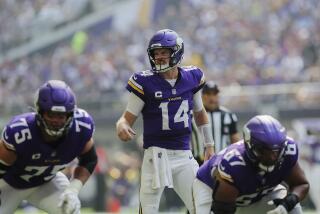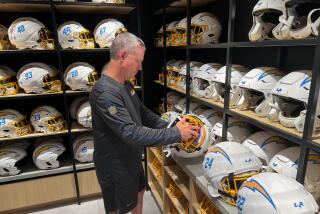HIGH ON ENDANGERED LIST : 10-Year Quarterback Veterans Becoming a Thing of Past in the New Most-Dangerous Game
- Share via
The 10-year quarterback, that venerable warhorse, is a dying breed that not long ago flourished on the plains of the National Football League.
Had it not been for the career-best effort this season by Minnesota’s Tommy Kramer, 31 and in his 10th NFL season, sirens might be signaling that the 10-year quarterback has gone the way of the straight-on kicker.
The torch finally has been passed this season. The quarterbacking elite of the NFL derives from the Class of ‘83, with Dan Marino, Ken O’Brien, John Elway, Jim Kelly and Tony Eason, plus a few from the Class of ‘85, including Bernie Kosar, Boomer Esiason and Jay Schroeder.
Consider how, until two weeks ago, the top seven passers in the American Football Conference were all third- and fourth-year players. That’s when the Raiders’ remarkable Jim Plunkett, at 39 the league’s oldest quarterback now in his 16th season, finally had thrown enough passes to qualify for the leader board.
Consider how in 1983, only three seasons ago, seven of the top 20 rated passers in the NFL were in at least their 10th season, including league MVP Joe Theismann and rating leader Steve Bartkowski. Five other top passers that season were in either their eighth or ninth years.
Now, three 10-year passers make the NFL top 20 and all have missed games because of injuries: Kramer, Plunkett and Philadelphia’s Ron Jaworski, whose 14th season ended more than a month ago when he tore a tendon in his passing hand.
The NFL roadside is littered with many savvy football relics who were pounded into submission over the past 36 months. Along with Theismann and Bartkowski, you’ll find Lynn Dickey, Ken Stabler, Brian Sipe, Gary Danielson and, from this season, Jaworski, Danny White, Dan Fouts et al., ad nauseam. Even eighth-year nimble-foot Joe Montana of the 49ers has spent more time in rehabilitation than in the huddle this season.
So what gives for the quarterback with a decade of experience? Has his time of prominence passed in the face of the pressure defenses of teams such as the Bears and Giants?
A survey of NFL players, coaches and scouts raised three possible explanations for what seems to be the rapid depletion of productive 10-year quarterbacks: The NFL’s most successful defenses stress maximum pressure on the quarterback, while leaving the flanks vulnerable.
Furthermore, these defenses are manned by players who are bigger and faster than ever before (offensive linemen may be bigger than ever, too, but they are still in the passive position). Consequently, NFL quarterbacks are suffering injuries at an alarming rate.
Older quarterbacks have taken the brunt over the past two seasons as their diminished reflexes have caused them to lose the “move or be moved” warfare with defensive players. Colleges have installed more pro-style passing offenses in recent years so that quarterbacks are entering the pros at a more advanced stage than ever before and are stealing the spotlight (and roster spots) from older veterans.
That quarterbacks don’t call their own signals further accelerates their readiness and banishes vets such as Miami’s Don Strock, New England’s Steve Grogan, Cincinnati’s Ken Anderson and Cleveland’s Danielson to the shadows, where they perform largely as tutors and confidants for their young successors.
Since 1983, the NFL has witnessed the end of one generation--a group of durable passers from the mid-’70s whose time had passed--and the beginning of another. It happens every five to 10 years, some say. “It’s just a cycle,” said Redskin General Manager Bobby Beathard.
The injuries to quarterbacks have been staggering this season. There have been 55 starting quarterbacks among the 28 NFL teams--up from 49 at this time in 1984--with 20 changes made because of injuries. Whether tortoise or hare, you’re not safe these days if you’re an NFL quarterback. Once the most glamorous NFL position, quarterback now is the most dangerous position.
Danielson, a 10-year man who has spent all season on the injured list, points out that teams are throwing more now than in the early ‘70s. “It used to be that 30 passes in a game was a lot,” he said, “and now 45 is not uncommon. So quarterbacks are getting hit now more than ever.”
He said that Kosar approached him after the Raiders treated him like Marvelous Marvin Hagler’s speed bag, knocking Kosar to the ground nearly 30 times in a loss early in the season.
“Bernie was beaten to a pulp, and he shook his head and said to me, ‘Hard day at the office,’ ” Danielson recalled. “I told him, ‘Yeah, Bernie, and only another 12 years to go.’ ”
Jaworski said he is awed by the size and speed of today’s defenders. With a half-laugh, he said, “Each year I see these guys coming out of college with no necks, and I wonder, ‘Where are they getting their genes from?’ ”
Dallas’s offensive coach, Paul Hackett, gave a more strategic explanation: “The pressure defenses of today are so complex and so tough that what’s happening is there are (defensive) people coming free to the quarterback. For years you didn’t have that. It’s blitzing, but it’s also teams playing multiple defenses with numerous substitutions.
“Look at the Redskins. They play a fairly straightforward defense. Then they play the 49ers on a Monday night with a five-man front, a three-man front, a 4-2 defense and then a 4-3--and they do it all within six plays! What happens is an offensive lineman misses an assignment and a guy comes streaming in. If you’re not as nifty as Joe Montana, you’re knocked out. How long can a Danny White or a Steve Bartkowski stand in there?”
Ernie Accorsi, an executive with the Cleveland Browns, pointed to the colleges, saying, “Colleges have gone out of the wishbone era. Look how (Illinois Coach) Mike White has revolutionized the Big Ten with passing. Even Ohio State and Michigan are passing now. All across the country, colleges are passing. The University of Miami wasn’t even on the college map 10 years ago and look at the quarterbacks they’ve produced since--Jim Kelly, Bernie Kosar and now Vinny Testaverde.
“Whereas NFL teams might have hung on longer with an older quarterback years ago, now they don’t. If Tony Eason doesn’t come out of Illinois, I’m sure (12-year vet) Steve Grogan would be playing there now. Years ago, you’d see Johnny Unitas getting hurt, and you’d pick up an Earl Morrall, or Bobby Layne would get hurt, and you’d pick up a Tobin Rote. . . . Sonny Jurgensen probably didn’t even throw 20 passes in his senior year (at Duke). But times have changed.”
Like Beathard, Giants’ General Manager George Young and Jets’ personnel director Mike Hickey are among those who believe the quarterbacking evolution has run its natural course.
“Maybe 35 years old is the barrier for quarterbacks in this league,” Young said. “Ten or 12 years will wear a quarterback out. It’s the natural selection of competition that has hastened the demise of these guys, that’s all. This will ultimately be the fate of the Class of ’83 and ‘84, too-it’s called Father Time.”
And Hickey added, “You can overanalyze things. I don’t think anybody would be knocking out Dan Fouts (of San Diego, who missed a month because of injuries this season) in the prime of his career. I just think it’s a case where some quarterbacks have gotten too old. It’s not a matter of mobility, as some will say. You’ve always had more mobile and less mobile quarterbacks over the years. Norm Van Brocklin ran like an old washer woman, but don’t tell me he couldn’t throw that pill.”
Once upon a time, coaches spoke of the five-year developmental plan for quarterbacks. And now? “It still is there,” Dallas’ Hackett said, “if a coach can still do it. What’s been happening is the older quarterbacks have been getting nicked earlier. The pressure defenses are forcing injuries. That’s pressing younger quarterbacks into duty faster than what you would like. The minimum time for a quarterback, I think, is two years.
“It takes a whole year for a guy to understand his system and a whole second year to take that system and to attack defenses. In the third year you begin to see a quarterback put at the second level, a backup. By his fourth year, he ought to be ready to be a player.”
Soon, Hackett said, “offenses will face this problem and begin designing things with more (blocking) protection and you’ll see the emergence of a very fast receiver who can put bigtime pressure on a defense and get down field for the big play, like a Jerry Rice or a Mike Sherrard.”
Of the dozen 10-year-plus quarterbacks still hanging by a thread in the NFL, only three are starters: Kramer, the recuperated Fouts, 35, and Plunkett. No wonder Jaworski, who has been replaced by rabbit Randall Cunningham and whose career might be over, says he expects quarterbacks’ lifespans will be shortened.
“When I came into the league,” said the Vikings’ Kramer, “the good linebackers of today--the Lawrence Taylors and Andre Tippetts and Wilbur Marshalls, the guys who come in at you with a full head of steam--they weren’t as prevalent as they are now. You had smaller, faster guys or bigger, slower guys.”
So how do you save the young quarterbacks, let alone the old ones? “The objective in baseball is to knock out the pitcher,” Danielson said, “and the objective in football is to knock out the quarterback. I think the in-the-grasp rule they have now is nice, and I don’t see them going any farther than that.”
Detroit’s Joe Ferguson, a 14-year player who started four recent games and now is sidelined with a knee swollen from the pounding, said, “I don’t know what changes to make. You can’t play touch football. Sad to say, defenses think quarterbacks have too much protection now.
“Maybe the justification is we get paid more than anyone else.”
More to Read
Go beyond the scoreboard
Get the latest on L.A.'s teams in the daily Sports Report newsletter.
You may occasionally receive promotional content from the Los Angeles Times.










